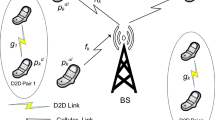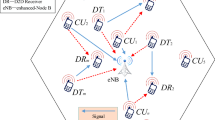Abstract
D2D (Device-to-Device) communication is one of the promising technologies in the LTE (Long Term Evolution)-Advanced communication network. From system perspective, this technology can increase frequency efficiency of the whole macro cell. From user perspective, however, a D2D pair which shares the same frequency resource of CUE (Cellular User Equipment) can cause interference with the CUE in the downlink. Thus, reducing interference for the cellular users and allocating frequency resource for the D2D pairs are important in D2D communication. In this paper, two resource allocation schemes which are based on PSO (Particle Swarm Optimization) and hybrid PSO-GA (Genetic Algorithm) are proposed to maximize the system throughput by allowing up to two D2D pairs to share the same frequency resource with one CUE. Moreover, a scheme has been considered to mitigate the interference caused to CUEs. The simulation results show that service of CUEs and system performance can be effectively guaranteed by using the proposed schemes.










Similar content being viewed by others

References
Doppler K, Rinne M, Wijting C, Ribeiro C, Hugl K (2009) Device-to-device communication as an underlay to LTE-advanced networks. IEEE Commun. Mag 47(12):42–49
Phunchongharn P, Hossain E, Kim D (2013) Resource allocation for device-to-device communications underlaying LTE-advanced networks. IEEE Wireless Commun 20(4):91–100
Yu C, Tirkkonen O, Doppler K, Ribeiro C (2009) Power optimization of device-to-device communication underlaying cellular communication. In: Proceedings of the 2009 IEEE ICC on internet measurement. IEEE, Dresden, pp 1-5
Peng T, Lu Q, Wang H, Xu S, Wang W (2009) Interference avoidance mechanisms in the hybrid cellular and device-to-device systems. In: Proceedings of the 2009 IEEE 20th International Symposium, IEEE, Tokyo, pp 617-621
Lee DH, Choi KW, Jeon WS, Jeong DG (2013) Resource allocation scheme for device-to-device communication for maximizing spatial reuse. In: Proceedings of the IEEE Wireless Communications and Networking Conference. IEEE ,Shanghai, pp 112-117
Su L, Ji Y, Wang P, Liu F (2013) Resource allocation using particle swarm optimization for the D2D communication underlay of cellular networks. In: Proceedings of the IEEE Wireless Communications and Networking Conference. IEEE, Shanghai, pp 129-133
Kiranyaz S, Ince T, Yildirim A, Gabbouj M (2010) Fractional particle swarm optimization in multidimensional search space. IEEE Trans Syst, Man & Cybernetics. Part B: Cybernetics 40(2):298–319
Premalatha K, Natarajan AM (2009) Hybrid PSO and GA for global maximization. Intl Jour. Open Problems in Compt. Math. 2(4):597–608
Kennedy J, Eberhart R (1995) Particle swarm optimization. In: Proceedings IEEE ICNN 1995. IEEE, Perth, pp 1942-1948
Deb K, Pratap A, Agarwal S, Meyarivan T (2002) A fast and elitist multiobjective genetic algorithm: NSGA-II. IEEE Trans. Evolutionary Comput 6(2):182–197
Doppler K, Yu CH, Ribeiro C.B, Janis P (2010) Mode selection for device to device communication underlying an LTE-Advanced network. In: Proceedings of the IEEE WCNC 2010. IEEE, Sydney, pp 1-6
3GPP (2011) TS 136 355 V9.4.0, LTE positioning protocol
3GPP (2012) TR 37.976 V11.0.0, TSGRA measurement of radiated performance for multiple input multiple output (MIMO) and multiantenna reception for high speed packet access (HSPA) and LTE terminals
WINNER II channel models, WINNER II D1.1.2, 2007. http://www.ist-winner.org
Zulhasnine M, Huang CC, Srinivasan A (2010) Efficient resource allocation for device-to-device communication underlaying LTE network. In: Proceedings of the IEEE Wireless and Mobile Computing, Networking and Communications 2010. IEEE, Niagara Falls, pp 365-375
Acknowledgments
This research was supported in part by Basic Science Research Program through the NRF funded by the MOE, Korea (2013R1A1A2059500), and by Human Resources Development Program of KETEP grant funded by the MOTIE, Korea (20134010200570).
Author information
Authors and Affiliations
Corresponding author
Rights and permissions
About this article
Cite this article
Sun, S., Kim, KY., Shin, OS. et al. Device-to-device resource allocation in LTE-advanced networks by hybrid particle swarm optimization and genetic algorithm. Peer-to-Peer Netw. Appl. 9, 945–954 (2016). https://doi.org/10.1007/s12083-015-0424-1
Received:
Accepted:
Published:
Issue Date:
DOI: https://doi.org/10.1007/s12083-015-0424-1



